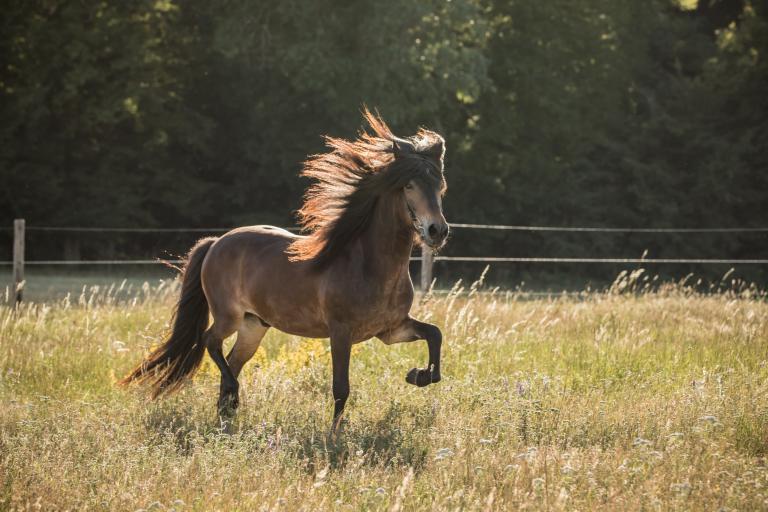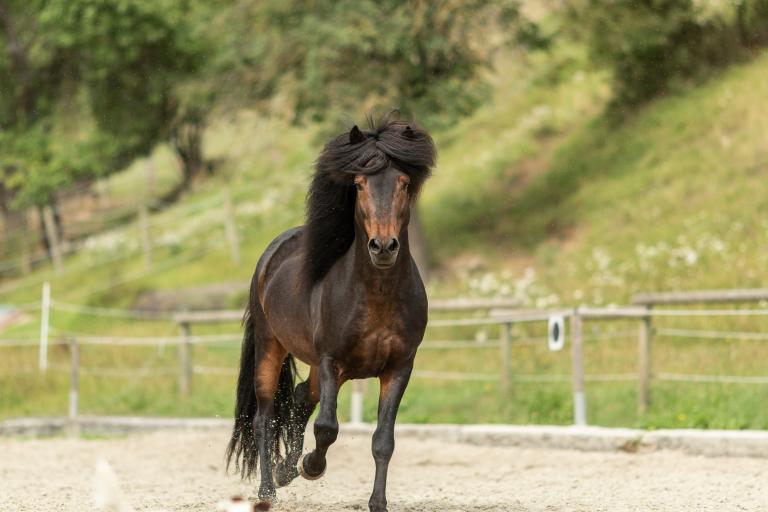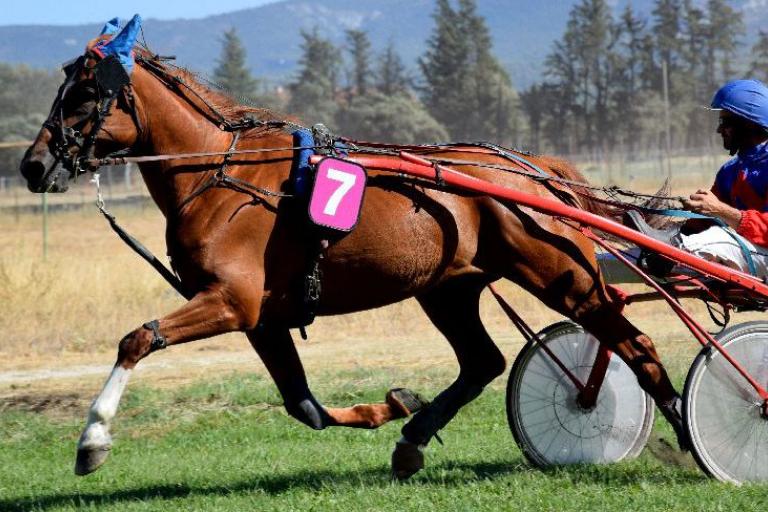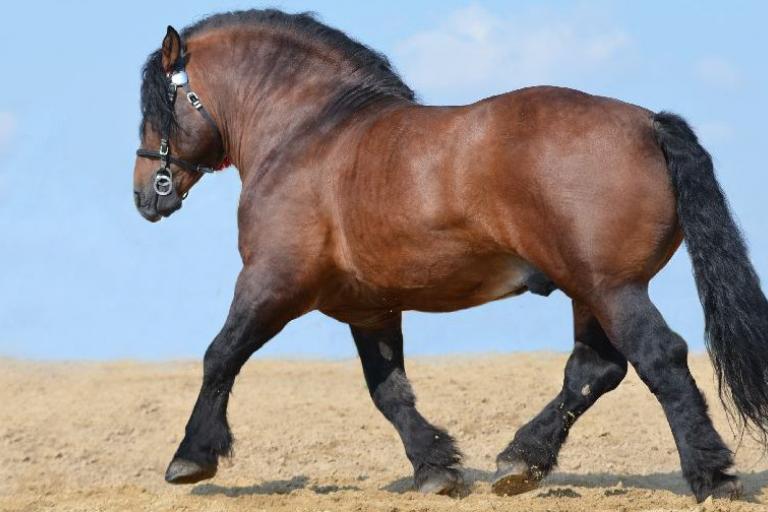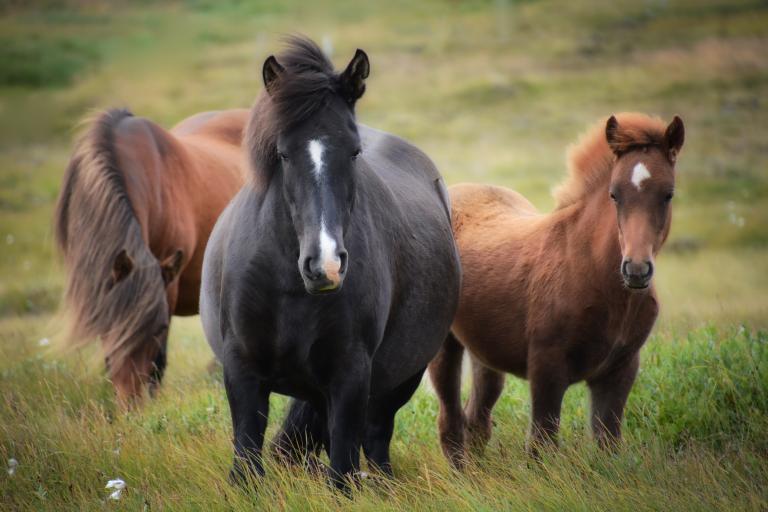Gait-Test Horse (SynchroGait®)
The SynchroGait®-Test is able to identify the genetic key factor responsible for the leg coordination. With this information we can predict a horse’s performance in two different categories:
- Flying pace for breeds participating in harness-races
- Natural capacity for alternative gaits in certain breeds ("gaited" horses)
Genotype and Lab Report
It is a nonsense mutation in the DMRT3 gene.
CC - The horse is a classical three-gaited horse (rarely even four-gaited).
- This genotype may be the optimum genotype for horses used for show jumping, eventing high-level classical dressage and gallop racing.
- If bred to an AA genotype, 100% of the offspring will be potentially four-gaited horses (CA).
- If bred to a CA horse, only about 50% of the offspring will be four-gaited (CA). The rest will be three-gaited as well (CC).
- The genotype may be “hidden” in a three-gaited horse because the horse has not been trained to amble (e.g. among Morgan horses 40% of CA individuals were classified as three-gaited by their owners).
- Better talent for canter than AA horses.
- If bred to an AA genotype → about 50% of the offspring will be four-gaited (CA), 50% potentially five-gaited horses (AA).
- If bred to an CC genotype → about 50% of the offspring will be four-gaited (CA), 50% classic three-gaited (CC).
- If bred to an CC genotype → 100% of the offspring will be potentially four-gaited horses (CA).
- If bred to a CA horse, about 50% of the offspring will be four-gaited (CA). The rest will be five-gaited as well (AA).
Standarbreds und French Trotters
Does your horse have the genetic potential to be a successful Trotter?
The fact that far from all Standardbreds ever start racing professionally shows how important it is to be able to predict the future performance of your horse. The success of your horse depends on many different factors – the SynchroGait® test enables you to identify one highly important genetic factor: a genetic predisposition for regular trotting at high speed. One of the key concerns of anyone who works with trotting horses is for their horses to start racing professionally. This is more likely to take place if your horse has two copies of the favourable genetic variant.
How can this test help you?
- Test a youngster for its genetic potential even before it has been trained.
- You receive information about your horse’s genetic potential for regular trotting at high speed.
- Save money by not investing in horses that need more training before they can start racing professionally.
- Quicker progress in your breeding work.
Research results in brief
- In a blind study of 61 horses, two had difficulties to keep a clean trot at competition pace. Both were CA, while all the others were AA.
- Out of a hundred horses tested from the same age group, 8% of the horses that did not start racing professionally and 0% of the top horses were CA.
- AA horses had a significantly higher breeding value (BLUP) than CA horses.
- AA horses earned significantly more prize money than CA horses.
- A difference of more than SEK 50,000 in prize money was observed in a comparison of CA and AA offspring between the ages of three and five that came from the same stallion. A significantly higher percentage of CA offspring never started to race professionally.
- CC and CA appear more frequently in French horses, which helps to explain why they tend not to be natural trotting horses (at hight speed).
Coldblooded (Draft) Trotters
What genetic potential does your Coldblooded horse have for trotting?
A major change has been seen in Coldblooded trotters in recent decades. They have become lighter and quicker. The gene variant for quick trotting seems to have crossed into Coldblooded trotters, improving their trotting technique. You can use the SynchroGait® test with Norwegian Coldblooded trotters, Swedish Coldblooded trotters and Finnhorses.
How can this test help you?
- You can choose to work with horses that have the genotype you want.
- It gives you valuable information when planning your breeding work.
- You can tailor your horse’s training programme to its genotype.
- You can test for this gene variant at a young age, when the horse is just a foal.
Research results in brief
- A blind study showed a significant correlation between a horse’s trotting technique and its genotype.
- CA horses are described as ‘clean trotting trotters’, CC horses find it more difficult to coordinate their legs while trotting at high speed, while AA horses have a natural talent for pace and rarely have difficulty coordinating their legs in trot at high speed.
- A blind study revealed that AA and CA horses have better capacity than CC horses.
- CA horses earned almost twice as much prize money as CC horses between the ages of three and six among the horses that we tested.
Icelandic horses
Does your horse have the genetic potential to be a four-gaited or five-gaited horse?
Genetics play a crucial role in whether a horse can perform flying pace or not. Research has identified the gene and “gait-keeper mutation” that permits this gait. It has been shown that flying pace has a very simple genetic inheritance pattern in Icelandic horses and that a horse needs to have two copies of the genetic variant permissive for pace (A) in order to perform the gait.
How can this test help you?
- Test breeding animals and then cross the combination that optimizes the chances of getting offspring with the gaits you prefer.
- Breed two four-gaited horses but eliminate the risk of CC offspring.
- To predict the gaits of a youngster that has at least one four-gaited parent.
- If you are not sure whether you should initiate pace training with your horse, to avoid pressuring CA and CC horses in attempts at flying pace.
Research results in brief
- Among over 400 tested five-gaited horses, all were AA except for 13 CA-horses. However, the average score of the CA horses for pace was 5.92.
- The distribution among horses shown as four-gaited at breeding field tests was 52% CA, 3% CC and 45% AA.
- CA horses had a significantly higher average score for the basic gaits of walk, trot, canter and gallop.
- AA horses had a significantly higher score for tölt. However, there was no difference for “slow tölt”.
- CC horses are often very difficult to put into tölt in the beginning of their training (CC= 5.1, CA= 4.0, AA= 2.2*).
*On a scale 1-6, where 6 is most difficult
Other Gaited Horses
Locomotion is a complex trait
Gaits in horses are influenced by several factors, both genetic and environmental. The summary above is what we see most often, but there are exceptions. Horses can to some extent be trained to re-shape their natural pattern of locomotion.
Conformation also has an impact on the gaits and we have had reports of CC horses that are gaited and AA horses that seem unable to perform pace. However, these instances are quite rare and the gait-gene has a proven dramatic impact on horses’ gaits.
When is it good to know the horse’s genotype?
- To plan mating in order to maximize the chances of getting a horse with the pattern of locomotion that the owner prefers.
- To predict the gaits of foals and young horses (i.e. for buying/selling youngsters).
- To match the right discipline, training, and rider with the right horse.
- To avoid pressuring a CC horse in attempts to amble or pace.
- Keep a distinct part of the population as classical three-gaited horses or as gaited horses by taking informed breeding decisions.
Research in brief
- Significant correlation between gaitedness and genotype in Icelandic horses, Morgan horses, American Curly horses, Finnhorses and Nordic trotters.
- Out of 81 tested Mangalarga Marchadora all AA horses presented the gait Marcha Picada (lateral coupling), all CC horses the gait Marcha Batida (diagonal coupling), while CA horses presented either of these two.
- Some Icelandic CC horses can be taught to amble but they are significantly more difficult in the beginning of the training. AA horses are easiest to set into tölt in the initial training (CC= 5.1, CA= 4.0, AA= 2.2, scale to 6.0**).
- CA Standardbreds have significantly better balance in canter and higher score for show Jumping than AA horses.
- Similarly, CA Icelandic horses have higher scores for the basic gaits compared to AA horses.
*The breed has been breed for gaitedness for centuries and thus has a conformation suitable for this purpose. **Where 6.0 is most difficult.
Literature
Jäderkvist Fegraeus, K., Hirschberg, I., Árnason, T., Andersson, L., Velie, B.D., Andersson, L.S., Lindgren, G.: To pace or not to pace: a pilot study of four- and five-gaited Icelandic horses homozygous for the DMRT3 'Gait Keeper' mutation. Anim Genet 48:694-697, 2017. Pubmed reference: 29023800. DOI: 10.1111/age.12610.
Regatieri, I.C., Eberth, J.E., Sarver, F., Lear, T.L., Bailey, E.: Comparison of DMRT3 genotypes among American Saddlebred horses with reference to gait. Anim Genet 47:603-5, 2016. Pubmed reference: 27295976. DOI: 10.1111/age.12458.
Andersson, L.S., Larhammar, M., Memic, F., Wootz, H., Schwochow, D., Rubin, C.J., Patra, K., Arnason, T., Wellbring, L., Hjälm, G., Imsland, F., Petersen, J.L., McCue, M.E., Mickelson, J.R., Cothran, G., Ahituv, N., Roepstorff, L., Mikko, S., Vallstedt, A., Lindgren, G., Andersson, L., Kullander, K.: Mutations in DMRT3 affect locomotion in horses and spinal circuit function in mice. Nature 488:642-6, 2012. Pubmed reference: 22932389. DOI: 10.1038/nature11399.
Further information is available at Online Mendelian Inheritance in Animals.


